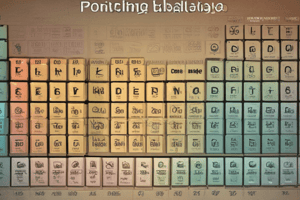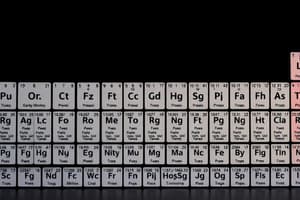Podcast
Questions and Answers
What characteristic is NOT typical of metals?
What characteristic is NOT typical of metals?
- Brittle (correct)
- Good conductors
- Ductile
- Malleable
Which property is associated with nonmetals?
Which property is associated with nonmetals?
- Brittle (correct)
- High boiling points
- Ductile
- Good conductors
In which direction does the reactivity of elements generally increase on the periodic table?
In which direction does the reactivity of elements generally increase on the periodic table?
- Right to left
- Left to right (correct)
- Upward
- Downward
Which of the following describes metalloids?
Which of the following describes metalloids?
What type of information is included in the periodic table?
What type of information is included in the periodic table?
What two natural isotopes of chlorine are identified?
What two natural isotopes of chlorine are identified?
How many neutrons does chlorine-35 have?
How many neutrons does chlorine-35 have?
What observation can be made when looking down a column of the secret agent table?
What observation can be made when looking down a column of the secret agent table?
What is the atomic mass of chlorine calculated using the provided formula?
What is the atomic mass of chlorine calculated using the provided formula?
As you look across a row of the secret agent table, what is the main relationship observed?
As you look across a row of the secret agent table, what is the main relationship observed?
What is the percentage composition of chlorine-37?
What is the percentage composition of chlorine-37?
Which isotope of chlorine has the greater mass?
Which isotope of chlorine has the greater mass?
Which of the following best defines 'periodicity' based on the context?
Which of the following best defines 'periodicity' based on the context?
What is one of the changes observed in the stomachs when analyzing the column of the secret agent table?
What is one of the changes observed in the stomachs when analyzing the column of the secret agent table?
What is an incorrect assertion about the secret agent table?
What is an incorrect assertion about the secret agent table?
Which element has the atomic number 14?
Which element has the atomic number 14?
What is the atomic mass of Nitrogen?
What is the atomic mass of Nitrogen?
Which of the following elements is located in Group 15 of the periodic table?
Which of the following elements is located in Group 15 of the periodic table?
Which element has the highest atomic number listed in the table so far?
Which element has the highest atomic number listed in the table so far?
What trend is noted regarding the reactivity of elements in the periodic table?
What trend is noted regarding the reactivity of elements in the periodic table?
What does the atomic number of an element represent?
What does the atomic number of an element represent?
Where is the atomic mass of an element usually located in its diagram?
Where is the atomic mass of an element usually located in its diagram?
Which of the following accurately describes the electron configuration diagram of an element?
Which of the following accurately describes the electron configuration diagram of an element?
What does the element symbol represent?
What does the element symbol represent?
Which item is NOT typically included in an element's diagram?
Which item is NOT typically included in an element's diagram?
Flashcards
Metal Property
Metal Property
Metals are good conductors, malleable, and ductile.
Nonmetal Property
Nonmetal Property
Nonmetals are poor conductors, have low boiling points, and are brittle.
Metalloid Property
Metalloid Property
Metalloids have properties of both metals and nonmetals.
Periodic Table Organization
Periodic Table Organization
Signup and view all the flashcards
Element Reactivity
Element Reactivity
Signup and view all the flashcards
Secret Agent Table Relationships (Column)
Secret Agent Table Relationships (Column)
Signup and view all the flashcards
Secret Agent Table Relationships (Row)
Secret Agent Table Relationships (Row)
Signup and view all the flashcards
Periodicity
Periodicity
Signup and view all the flashcards
Periodic Table
Periodic Table
Signup and view all the flashcards
Isotope
Isotope
Signup and view all the flashcards
Chlorine-35
Chlorine-35
Signup and view all the flashcards
Chlorine-37
Chlorine-37
Signup and view all the flashcards
Atomic Mass
Atomic Mass
Signup and view all the flashcards
Why is chlorine's atomic mass not a whole number?
Why is chlorine's atomic mass not a whole number?
Signup and view all the flashcards
Atomic Number
Atomic Number
Signup and view all the flashcards
Element Symbol
Element Symbol
Signup and view all the flashcards
Electron Configuration Diagram
Electron Configuration Diagram
Signup and view all the flashcards
What is a Period on the Periodic Table?
What is a Period on the Periodic Table?
Signup and view all the flashcards
Reactivity Trend
Reactivity Trend
Signup and view all the flashcards
Study Notes
Periodic Table Notes
- The periodic table shows the elements arranged by atomic number.
- Elements are grouped based on similar properties.
- Metals are typically shiny, good conductors, malleable, and ductile.
- Nonmetals are typically poor conductors, have low boiling points, and are brittle.
- Elements in the same group have similar chemical properties.
- Elements in the same period have increasing reactivity from left to right.
- Atomic number increases across a period.
- Atomic mass also increases across a period.
Studying That Suits You
Use AI to generate personalized quizzes and flashcards to suit your learning preferences.




